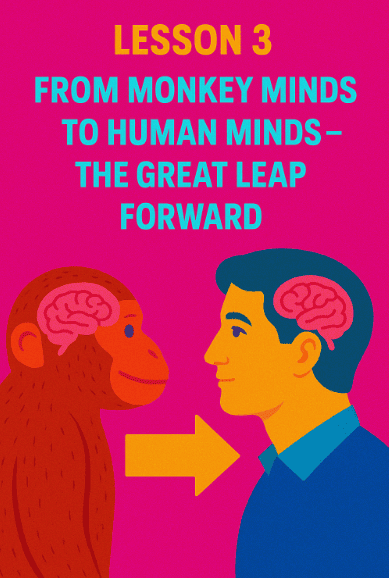
Recap from Last Time
In Lesson 2, we learned about dinosaurs with tiny brains compared to their huge bodies, and how mammals—with smaller but smarter brains—eventually took over after the dinosaurs went extinct. We discovered that flexibility and adaptability in brains mattered more than size.
Now we fast-forward millions of years to meet our closest relatives: the primates. This is where the journey of the human brain really begins.
Meet the Primates 🐒
Primates are a group of mammals that include monkeys, apes, and humans. They appeared about 55 million years ago.
What makes primates special?
-
Big eyes and good vision: Great for seeing in forests.
-
Flexible hands and feet: For climbing and grabbing things.
-
Social groups: Living in families or troops, which requires communication.
-
Larger brains compared to body size: Especially for solving problems and remembering things.
Even though early primates were small tree-dwellers, they already had the brain foundation for something greater.
The Brain’s Upgrade: The Neocortex 2.0 🧠
Remember from Lesson 2 that mammals had a neocortex—the wrinkly outer layer of the brain. In primates, the neocortex became even more developed.
This upgrade gave primates special powers:
-
Better vision: Seeing colors, depth, and details.
-
Memory for social relationships: Remembering who is friendly and who is dangerous.
-
Tool use beginnings: Using sticks or stones to get food.
The neocortex was like a smartphone upgrade—it allowed much more “apps” (skills and behaviors) to run on the same hardware.
Monkeys vs. Apes 🐒 vs 🦍
Around 25 million years ago, primates split into two big groups:
-
Monkeys – More species, often smaller, with tails, and brains suited for climbing and quick survival.
-
Apes – Larger, no tails, bigger brains, more complex social lives.
Apes include chimpanzees, gorillas, orangutans, bonobos, and eventually humans.
Apes had a much larger encephalization quotient (EQ) than monkeys, meaning their brain size compared to their body was bigger. This allowed more complex thought, like planning, cooperation, and even early forms of culture.
What Apes Can Do (That Hint at Us) 🦧
Modern apes give us a window into what early ape brains could do:
-
Chimpanzees use sticks to fish termites out of holes.
-
Gorillas and bonobos show empathy (they comfort each other).
-
Orangutans can remember where fruit trees are located, even years later.
-
Some apes even show signs of basic language using symbols or gestures.
These abilities show us that long before humans, brains were already experimenting with intelligence.
The Leap Toward Humans 🧑🦲➡️🧠
Something extraordinary happened about 2 to 3 million years ago. A group of apes in Africa began evolving larger and larger brains. These early human relatives are called hominins.
Why did their brains grow so much? Scientists think it was because of several pressures:
-
Environment changes – Forests were shrinking, grasslands were spreading. To survive, these apes needed new skills, like traveling long distances and finding food in different ways.
-
Tool use – Making stone tools required planning, memory, and teaching.
-
Social groups – Living together in bigger groups meant brains had to handle complex social rules, cooperation, and competition.
-
Cooking and food – Later, when humans discovered fire, cooking made food easier to digest, giving more energy for bigger brains.
This was the Great Leap Forward—brains that could not just react, but also plan, remember, communicate, and innovate.
Brain Growth Numbers 📊
-
Early apes (7 million years ago): ~400 cubic centimeters (similar to chimpanzees today).
-
Early humans like Homo habilis (2 million years ago): ~600–700 cc.
-
Homo erectus (1.5 million years ago): ~900–1000 cc.
-
Modern humans (Homo sapiens): ~1300–1400 cc.
That’s more than tripling in size in just a few million years—a blink in evolutionary time.
The Social Brain Hypothesis 👥🧠
Scientists have a fascinating idea called the social brain hypothesis.
It says: our brains grew large not just to make tools or find food, but mainly to handle social relationships.
Think about it:
-
Remembering who is your ally.
-
Negotiating peace after fights.
-
Working together to hunt or gather food.
-
Teaching children skills.
Living in complex groups required communication, memory, empathy, and problem-solving. These pressures pushed brains to grow.
Language: The Game-Changer 🗣️
At some point in the last 200,000 years, human ancestors developed language.
Language wasn’t just making noises—it was a way to:
-
Share knowledge.
-
Teach skills.
-
Tell stories (which carried survival lessons).
-
Organize large groups.
Language may be the most important leap that separated humans from other primates. It turned knowledge into something that could be passed on and improved generation after generation.
A Tale of Two Tribes 🌍🔥
Imagine two early human tribes 100,000 years ago.
Tribe A: Small brains, no real language. They hunt but can’t share detailed instructions. They forget where food is if they don’t go there often.
Tribe B: Larger brains, with the beginnings of language. They can say, “The herd of animals moved toward the river yesterday.” They can plan hunts, divide work, and teach their children more effectively.
Which tribe survives and grows? Tribe B. That’s why brains + language = survival superpower.
Key Takeaways 🌟
-
Primates developed larger brains, flexible hands, and complex social lives.
-
Apes showed early intelligence with tool use, memory, and empathy.
-
Around 2–3 million years ago, human ancestors (hominins) began rapidly increasing brain size.
-
Tool use, environment, social groups, and cooking all pushed brains to grow.
-
Language gave humans the ultimate advantage, allowing knowledge to accumulate.